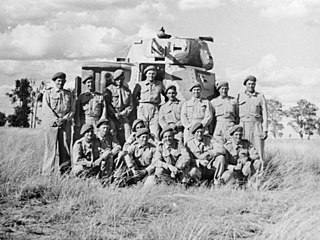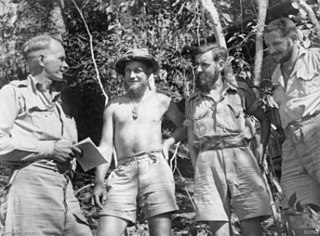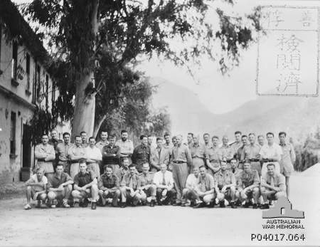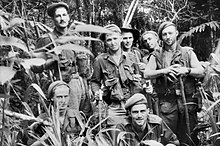
The Battle of Timor occurred in Portuguese Timor and Dutch Timor during the Second World War. Japanese forces invaded the island on 20 February 1942 and were resisted by a small, under-equipped force of Allied military personnel—known as Sparrow Force—predominantly from Australia, United Kingdom, and the Dutch East Indies. Following a brief but stout resistance, the Japanese succeeded in forcing the surrender of the bulk of the Allied force after three days of fighting, although several hundred Australian commandos continued to wage an unconventional raiding campaign. They were resupplied by aircraft and vessels, based mostly in Darwin, Australia, about 650 km (400 mi) to the southeast, across the Timor Sea. During the subsequent fighting, the Japanese suffered heavy casualties, but they were eventually able to contain the Australians.
The name commando has been applied to a variety of Australian special forces and light infantry units that have been formed since 1941–42. The first Australian "commando" units were formed during the Second World War, where they mainly performed reconnaissance and long-range patrol roles during Australia's campaigns in New Guinea and Borneo, although other units such as M and Z Special Units performed more clandestine roles. These units were disbanded following the end of the war; however, in the 1950s it was realised that there was a need for such units again in the Australian forces. Today, the Australian Army possesses a number of units that perform more conventional direct-action type commando roles, as well as counter-terrorism response, long-range patrolling, and clandestine deep-penetration operations.

Sparrow Force was a detachment based on the 2/40th Australian Infantry Battalion and other Dutch, British, US and Australian 8th Division units during World War II. The force was formed to defend the island of Timor from invasion by the Empire of Japan. It formed the main part of the Allied units in the Battle of Timor.

Armoured units made a relatively small, but important, contribution to Australia’s war effort during World War II. While Australia formed three armoured divisions and two independent armoured brigades during the war, Australian armoured units only saw action as independent regiments and companies supporting larger infantry formations. Early actions were fought in the Middle East by the divisional carrier regiments that supported the 6th, 7th and 9th Divisions, fighting in Libya, Egypt and Syria in 1941–42, before the Australian divisions returned to Australia in 1942–43. During the early fighting in the Pacific, there was a limited role for armoured formations, although one armoured regiment – the 2/6th – took part in the fighting around Buna–Gona in late 1942. Later in the war, though, during the Huon Peninsula, Bougainville and Borneo campaigns of 1943–45, several armoured units were used by Australian forces in the infantry support role.

The 2/6th Cavalry Commando Regiment was a cavalry regiment of the Australian Army that served during the Second World War and was later converted into a commando unit. Formed at Ingleburn, New South Wales, in November 1939, it was originally raised as an armoured reconnaissance regiment attached to the 6th Division. In that role, the 2/6th saw action in the North Africa campaign and in the Middle East during 1940–41, where the regiment distinguished itself at Bardia, Tobruk and in Syria. Later, following Japan's entry into the war, the 6th Division was brought back to Australia and following a re-organisation, the regiment was converted into a cavalry commando regiment, incorporating the independent companies that had been formed at the start of the war. In late 1944, the 2/6th Cavalry Commando Regiment was deployed to New Guinea, where it participated in one of the final Australian campaigns of the war in the Aitape–Wewak area.

Alexander Spence DSO was an Australian Army officer during World War II. Between 24 May and 11 November 1942, Spence commanded Allied forces during their guerrilla campaign in Timor.
The 2/4th Commando Squadron was one of 12 independent companies and commando squadrons raised by the Australian Army during the Second World War. Raised in August 1941, it was disbanded not long after due to conceptual problems, but it was quickly reformed following the entry of Japan into the war in December 1941. After a period of about six months performing garrison duties in northern Australia, the 2/4th was deployed to Portuguese Timor to reinforce the other Australian units already waging a guerilla war on the island. After a brief campaign the 2/4th was returned to Australia and from there it went on to serve in New Guinea in 1943, taking part in the Salamaua-Lae campaign attached to the 9th Division. Later, the squadron was involved in one of the last campaigns of the war when it landed on Tarakan Island in May 1945 and took part in the Borneo campaign. Following the end of hostilities, the 2/4th returned to Australia and was disbanded at Ingleburn, New South Wales, on 8 January 1946.

The 2/5th Commando Squadron was one of twelve independent companies and or commando squadrons of the Australian Army formed for service during World War II. Initially formed in 1942 as the "2/5th Independent Company", the 2/5th served in New Guinea, taking part in a major commando raid on Salamaua in June 1942. It was later withdrawn from New Guinea and reformed as the "2/5th Cavalry (Commando) Squadron", as part of the 2/7th Cavalry (Commando) Regiment which saw service in Borneo in 1945. It was disbanded in early 1946.

Merauke Force was an Australian-led military force of World War II which was responsible for defending Merauke in Dutch New Guinea from Japanese attack amidst the Pacific War. The force was established in late 1942 and was disbanded at the end of the war, having never seen combat. The Japanese attack did not eventuate and from mid-1944 the force was progressively drawn down and its assigned units redeployed to Australia or elsewhere in the Pacific. At its height, Merauke Force included troops from Australia, the Netherlands East Indies and the United States, as well as several squadrons of aircraft, including a joint Australian-Dutch fighter unit.

The 2/6th Commando Squadron was one of 12 independent companies or commando squadrons raised by the Australian Army during the Second World War. Raised in May 1942 as the 2/6th Independent Company, the 2/6th's main role was to conduct irregular type warfare including small scale raiding, sabotage, long-range patrolling and reconnaissance operations rather than the traditional commando type direct action operations. As such, for the most part the unit conducted operations in small groups operating inside enemy territory, or out in front of larger friendly forces. Between 1942 and 1945, the 2/6th undertook four major campaigns during the war—Kokoda, Buna, Markham–Ramu and Borneo—and was involved in arguably one of the most spectacular small unit actions of the war during the Battle of Kaiapit. The unit was disbanded in January 1946, following the cessation of hostilities in the Pacific.

No. 1 Independent Company was one of twelve independent or commando companies raised by the Australian Army for service in World War II. Raised in 1941, No. 1 Independent Company served in New Ireland, New Britain and New Guinea in the early stages of the war in the Pacific, taking part in a major commando raid on Salamaua in June 1942. Having lost a large number of men captured by the enemy as well as a number of battle casualties, the company was withdrawn from New Britain later in 1942. The company was subsequently disbanded, with its surviving members being transferred to other commando units, and it was never re-raised.
The 2/3rd Commando Squadron was one of twelve independent or commando companies and squadrons formed by the Australian Army for service during World War II. Raised in October 1941 as the 2/3rd Independent Company, it served in New Caledonia and New Guinea before being amalgamated into the 2/7th Cavalry Commando Regiment and adopting the name 2/3rd Commando Squadron in 1943. After this, the squadron did not see action again until 1945, when it participated in the Borneo campaign. Throughout the course of the war, the 2/3rd lost 69 members killed in action. No battle honours were awarded to the unit, although it participated in a number of notable engagements in these campaigns and its members received numerous decorations for their service. Following the end of hostilities in the Pacific, the unit was disbanded in early 1946, upon their return to Australia.
The 2/7th Commando Company was one of 12 independent companies or commando squadrons raised by the Australian Army during the Second World War. Raised in May 1942, as the 2/7th Independent Company, the 2/7th served in New Guinea in 1943 during the Salamaua–Lae campaign before being redesignated as the 2/7th Commando Squadron when it was amalgamated with two other commando squadrons to become part of the 2/6th Cavalry (Commando) Regiment. Later at the end of 1944, it was sent to New Guinea again, where it took part in the Aitape–Wewak campaign. Following the end of the war, the squadron was returned to Australia and disbanded early in 1946.
The 2/8th Commando Squadron was one of 12 independent companies or commando squadrons raised by the Australian Army during the Second World War. Raised in July 1942 as the 2/8th Independent Company, the 2/8th spent the early years of the war performing garrison duties in the Northern Territory. In July 1944, the 2/8th sailed to Lae, in New Guinea from where they launched a clandestine reconnaissance operation on the island of New Britain. Later, attached to the II Corps, it participated in the Bougainville campaign, during which it was in action continuously for a period of nine months right up until the Japanese surrendered in August 1945. Following the end of hostilities, the 2/8th returned to Australia, and was disbanded at Liverpool, New South Wales in early January 1946.
The 2/7th Cavalry (Commando) Regiment was one of three commando regiments raised by the Australian Army for service during World War II. It was originally raised as the 7th Division Cavalry Regiment in 1940 and in this guise it served in North Africa and the Middle East at the beginning of the war, before it was brought back to Australia and sent to New Guinea in late 1942 to serve against the Japanese. In mid-1943 the Australian high command decided to disband the divisional cavalry regiments and use their headquarters elements to administer the independent companies that had been raised earlier in the war. In the process the 7th Division Cavalry Regiment disbanded its squadrons, gave up their vehicles and changed its name to the 2/7th Cavalry (Commando) Regiment, as it became the administrative headquarters for the 2/3rd, 2/5th and 2/6th Commando Squadrons.

The 2/9th Commando Squadron was a commando unit raised by the Australian Army for service in World War II. Raised in 1944, the unit saw action late in the war against the Japanese during the Aitape–Wewak campaign taking part in number of long range patrol operations across the Torricelli Range in New Guinea before being used in an amphibious landing near Wewak in May 1945. After the war the unit was disbanded.

The 2/12th Commando Squadron was a commando unit raised by the Australian Army for service in World War II. Raised in 1944 following a re-organisation of Australia's military forces, the unit participated in the Borneo campaign in 1945 but played only a limited role before hostilities ended. Following the end of the war, the squadron returned to Australia and was disbanded in early 1946.

Harry Gladwyn Harcourt, was an officer in the British Army and later the Australian Army who commanded an Australian commando unit during the Second World War.

The New Guinea Air Warning Wireless, also known as the "New Guinea Air Warning Wireless Company", "NGAWW", or "The Spotters", was a unique signals unit of the Australian Army formed in January 1942 in Port Moresby, Territory of Papua, during World War II, to provide early warning of Japanese air attack, and subsequently providing surveillance of shipping and ground-based troops. During the first month of operations 16 stations were established, with positions set up along the Papuan coast as well as in the mountains near Port Moresby. They often operated behind Japanese lines and were at risk of being captured by the Japanese due to the nature of their operations, while a number of outstations were over-run and the men manning them killed. By the end of 1942 the company was maintaining 61 operational stations and had a strength of 180 men.

David St Alban Dexter was an Australian military historian, commando, diplomat and university administrator.

















